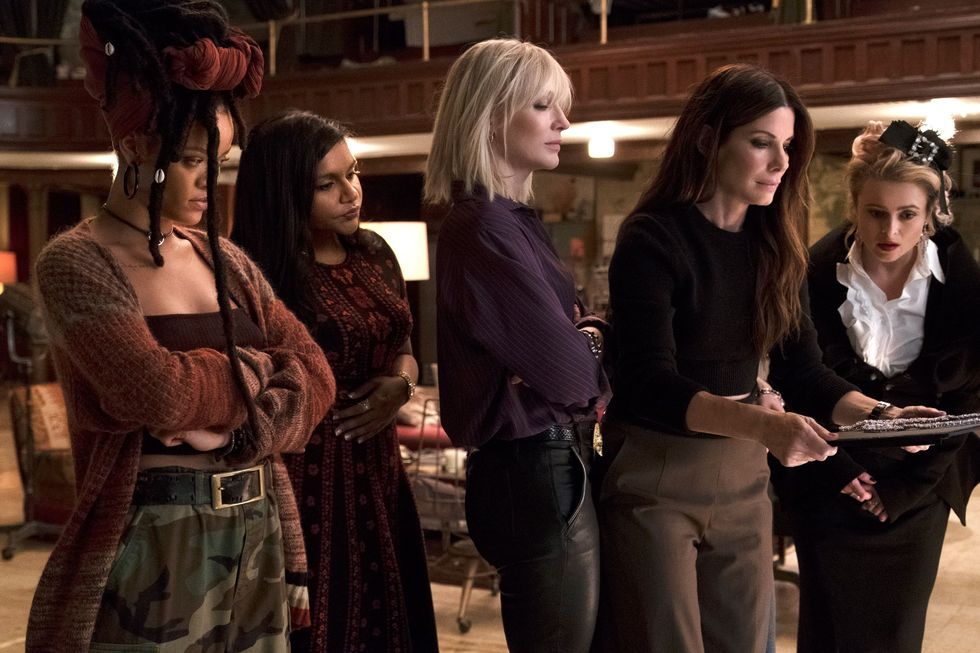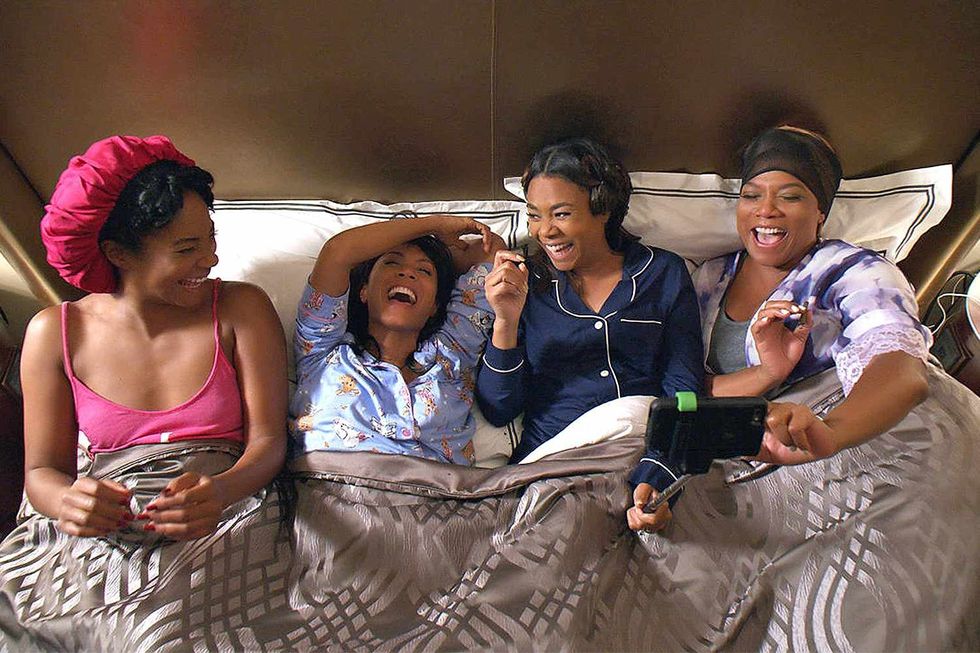
There’s something about an ensemble movie that gets my heart racing. The chance to see a wide array of famous actors interacting and committing to their roles.
But I have to admit, I get intimidated when I think about writing one of these movies or TV shows.
Writing for an ensemble cast in film and TV presents unique challenges and opportunities for a screenwriter.
Unlike traditional narratives that may focus on one or two main characters, ensemble casts require the writer to juggle multiple storylines, character arcs, and perspectives, all while maintaining a cohesive and engaging story.
So, how can a writer do it?
Today, I’m going to delve into strategies for writing effective ensemble casts, drawing on examples from successful films and TV shows. And, hopefully, we’ll leave with some confidence.
Let’s get started.
What is an Ensemble Movie or TV Show?

In ensemble films and TV series, the narrative doesn’t revolve around a single character’s journey but instead is built around the collective experiences, relationships, and developments of all the main characters.
This structure enables the audience to engage with a broader spectrum of personalities, backgrounds, and story arcs, offering a more nuanced and multifaceted view of the story’s world.
Examples of Ensemble Movies and TV Shows

Ensemble casts are common in genres that lend themselves well to multiple viewpoints, such as dramas, comedies, and science fiction series.
These shows and movies often use their ensemble casts to tackle a variety of themes and social issues, reflecting the complexities of real-life communities and interactions.
Let’s take a peek at a few examples.
Ensemble Movies
- The Grand Budapest Hotel (2014) – Directed by Wes Anderson, this film is known for its distinct visual style and a large ensemble cast. It tells the story of a famous hotel’s concierge and his friendship with a young employee against the backdrop of a changing Europe between the wars.
- Ocean’s Eleven (2001) – A heist film directed by Steven Soderbergh, featuring a star-studded cast including George Clooney, Brad Pitt, and Julia Roberts. The plot revolves around a plan to rob three Las Vegas casinos simultaneously.
- Pulp Fiction (1994) – Directed by Quentin Tarantino, this film interweaves several stories of crime and violence in Los Angeles, featuring a large ensemble cast including John Travolta, Uma Thurman, and Samuel L. Jackson.
- Crash (2004) – This film, directed by Paul Haggis, explores racial and social tensions in Los Angeles through the interlocking stories of a diverse group of characters over a 36-hour period.
- The Avengers (2012) – A superhero film directed by Joss Whedon, bringing together characters from previous Marvel films, including Iron Man, Captain America, and Thor, to form a team to save the world from an alien invasion.
Ensemble TV Shows
- Game of Thrones (2011-2019) – An epic fantasy series based on George R.R. Martin’s novels, known for its vast ensemble cast and complex characters, set in the fictional continents of Westeros and Essos.
- The Wire (2002-2008) – Created by David Simon, this series explores the life of Baltimore from the perspectives of law enforcers, drug dealers, and residents, focusing on the interconnectedness of society’s different sectors.
- Stranger Things (2016-present) – A science fiction horror series that follows a group of children in the 1980s as they encounter supernatural forces and secret government experiments, featuring a large ensemble cast of children and adults.
- Friends (1994-2004) – A sitcom revolving around a group of friends living in Manhattan, dealing with their personal and professional lives. The show is celebrated for its ensemble cast and has become a cultural phenomenon.
- Orange Is the New Black (2013-2019) – A comedy-drama series set in a women’s prison, featuring a diverse ensemble cast. The show explores the lives of the inmates, each with their own stories and backgrounds, highlighting issues of race, gender, and the criminal justice system.
How to Write Ensemble Casts in Film and TV?

When it comes to writing one of these screenplays, let’s look at a few strategies that can help someone wade into the waters of writing for ensembles.
I decided to put together a list of tips I’m using as I work on my own idea.
1. Conceptualize Distinct Characters
- Create Complex Personalities: Each character should have a unique and well-defined personality, background, and set of motivations. Think about how their individual traits will contribute to the group dynamics and story as a whole.
- Diverse Perspectives: Ensure your cast represents a range of perspectives, experiences, and backgrounds. This diversity can enrich the narrative and offer varied viewpoints on the story’s themes.
2. Define Relationships and Dynamics
- Interpersonal Relationships: Map out the relationships between characters, including friendships, rivalries, romances, and family ties. These relationships will drive much of the conflict and plot development.
- Group Dynamics: Consider how the ensemble functions as a unit. What binds them together? How do they interact in groups? Dynamics within the ensemble are crucial for creating engaging scenes and development.
3. Balance Screen Time and Importance
- Equitable Focus: While not every character can be in the spotlight all the time, ensure each key character has moments to shine and contribute significantly to the plot.
- Narrative Balance: Juggle multiple storylines by giving each one enough development and resolution. This might involve alternating focus between characters from one episode or scene to the next.
4. Develop Interweaving Storylines
- Multiple Arcs: Craft individual story arcs that feed into and intersect with the main narrative. These arcs can highlight personal growth, reveal important backstory, or introduce new conflicts.
- Cohesive Plotting: Find natural ways for these individual stories to intersect and affect one another, strengthening the overall narrative cohesion.
5. Utilize Ensemble Scenes
- Group Interactions: Create scenes that bring the entire ensemble together, using these moments to showcase the group’s collective chemistry and highlight individual contributions within the larger context.
- Key Moments: Use ensemble scenes for pivotal moments in the story, such as major conflicts, resolutions, or revelations, to emphasize their impact.
6. Ensure Distinct Voices
- Unique Dialogue: Each character should have a distinctive way of speaking that reflects their personality, background, and current emotional state. This helps audiences distinguish between characters and adds depth to their interactions.
- Character Development: Allow characters’ voices to evolve with their arcs, showing growth or change through their dialogue and actions.
7. Address Character Growth
- Evolution Over Time: Plan how each character will grow or change throughout the story. Ensemble casts offer a rich opportunity to explore varied paths of personal development.
- Interconnected Growth: Show how relationships and events within the ensemble influence individual characters’ growth, highlighting the interconnected nature of their journeys.
8. Maintain Narrative Focus
- Core Themes: Despite the multitude of characters and storylines, ensure there’s a clear thematic through-line that ties the narrative together. This can be a moral question, a societal issue, or a personal dilemma.
- Pacing and Structure: Carefully manage pacing to keep the story moving forward and maintain viewer interest. This may involve strategic cuts between storylines and ensuring each episode or scene advances the overall plot or character development.
Writing for an ensemble cast requires a delicate balance of character development, narrative pacing, and thematic cohesion. By focusing on clear roles, distinct voices, balanced storylines, and dynamic character interactions, writers can create memorable and impactful ensemble narratives.
As with any writing endeavor, the key is to remain flexible and open to the story’s evolving needs, ensuring that each character contributes meaningfully to the tapestry of the narrative.
Now, go get back to work.
Author: Jason Hellerman
This article comes from No Film School and can be read on the original site.
